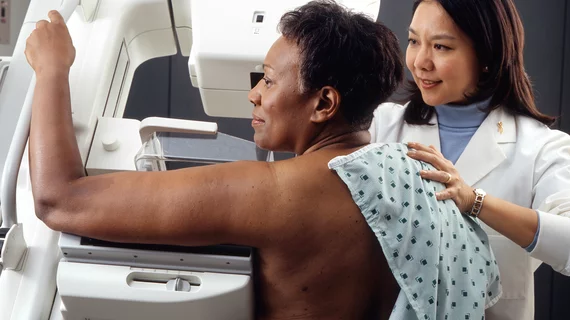The addition of shear-wave elastography to conventional breast ultrasound improves the characterization of low-suspicion masses, according to research published in Diagnostic and Interventional Imaging this month, possibly reducing the need for long-term follow-up and unnecessary biopsies in scores of women.
Though mammography is the common standard for assessing breast masses in the general female population, its low sensitivity—especially in dense breasts and younger women—means it’s often an inadequate imaging modality on its own, Smriti Hari, MD, of the department of radiology at the All India Institute of Medical Sciences in New Delhi, and co-authors wrote in the journal.
That’s where ultrasound comes in.
“More recent ultrasound techniques have led to better degrees of breast mass characterization,” Hari and colleagues from the departments of pathology, biostatistics and surgery at the All India Institute said. “Shear-wave elastography (SWE) helps estimate tissue stiffness based on the acoustically generated shear-wave propagation speed through the tissue and determine the nature of the mass.”
Since breast cancer tissue is harder than healthy breast tissue, the authors said, SWE could be a helpful tool in classifying that tissue and describing masses from a different perspective.
Hari and co-workers focused on BI-RADS category 3 and 4 masses for their research, both of which are low-suspicion categories. To determine if SWE would be a valuable addition to traditional ultrasound, the team conducted a prospective study of 119 women with a single breast mass. All patients underwent clinical breast exams, ultrasound and SWE and ultrasound-guided core biopsy of the breast mass, and the researchers took into account a host of SWE variables, including E-color, E-mean and E-max.
Histopathologically, the authors said, around half of breast masses were benign and half malignant. Ultrasound found 42 BI-RADS 3 and 77 BI-RADS 4 masses, indicating a specificity of 70 percent and a sensitivity of 97 percent. On SWE, Hari et al. wrote, benign masses were round, reasonably homogenous and blue or green with lower elasticity values. Malignant masses, on the other hand, were irregular, inhomogeneous and red or orange, with high elasticity values.
On modified BI-RADS using SWE parameters, specificity improved to 79 percent and 75 percent in benign and malignant masses, respectively.
“In our study, modified BI-RADS improved the overall specificity marginally without loss of sensitivity for BI-RADS 3 and 4a lesions,” the authors wrote. “Best improved specificity came by adding E-color to upgrade stiff BI-RADS 3 lesions and downgrade soft BI-RADS 4a lesions.”
Similar results were achieved with the addition of E-max and E-mean, they said.
SWE seems a promising adjunct to ultrasound, the paper read, but more about its additive role in imaging needs to be explored.
“Addition of SWE to ultrasound improves characterization of BI-RADS 3 and 4a masses,” Hari and colleagues said. “E-max, E-mean and E-color are the most useful SWE parameters to differentiate between malignant and benign breast masses.”

